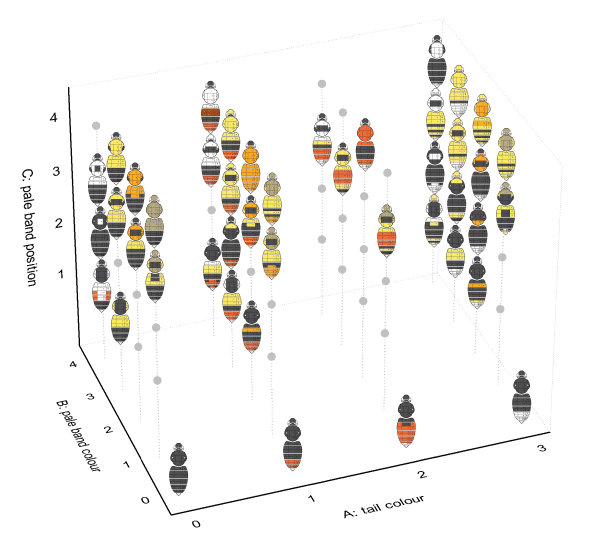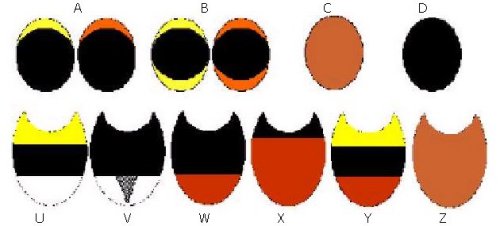|
Find
species by colour-pattern group
click
on a matching bee diagram:
Click
on the bee above that matches the predominant pale colour
of the 'tail'.
The 'tail' refers to the palest hair covering all or
parts of gastral terga 3-5. Bumblebees with a yellow
band on tergum 3 or 4, with no red on terga 3-5, and
with black immediately anteriorly, are counted as yellow
tailed. Bumblebees with terga 2-3 pale and terga 4-5
black are counted as black tailed.
This
classification was derived
using worker bumblebees alone and therefore excludes
Psithyrus.
Use
of colour for identification
Variation
within and among species
Defining colour-pattern groups
Background
on colour-pattern diagrams
New colour-pattern
diagrams
Key
to bumblebees of the world
.
Use
of colour for identification
Colour
pattern is used here to refer only to colours of the
body hair, not to the colour of the body surface (which
is black or brown). Because of the pronounced variation
within species and resemblance
among species, colour patterns, when used alone and
when considered only for the coarsely defined body
regions used here, are never going to be sufficient
to distinguish some species. Nonetheless, bumblebee
colour patterns have been used in most keys as an important
part of identifying species. The colour
key below can still be used to find quickly a small
number of the most likely candidates for closer morphological
comparison (e.g. by examining the genitalia
of the corresponding males), especially when combined
with a key to subgenus.
.
Variation
within and among species
Variation
within species. The example below for the Oriental
B. trifasciatus
complex (redrawn from Williams, 1991
[pdf] ), shows that bumblebee colour patterns can
be highly variable:
Resemblance
among species. In contrast, the table below
shows that bumblebee colour patterns can be closely
similar among species within the same geographical region
(in this case, very similar patterns to B. trifasciatus
above are shared and covary across southern Asia with
co-occuring species, including B. haemorrhoidalis
and B. breviceps).
Convergence
among species. Because these species belong
to distantly related subgenera,
the colour-pattern resemblances are likley to be the
result of evolutionary convergence. Convergence among
bumblebee colour patterns could be the result of several
different kinds of processes, including selection for
the advantages that particular patterns may confer for
thermoregulation, cryptic protection, and mimetic protection
(Williams, 2007 [pdf]).
For these particular species, mimetic convergence is
likely to be a major component because of the complexity
and precision of the mimicry.
.
Defining
colour-pattern groups
Geographically
based colour-pattern groups similar to those shown above
from southern Asia can be described among bumble bees
from many parts of the world (Williams, 2007
[pdf]). A classification of colour-pattern groups
needs only simple rules, which are based here on large
flexibly-defined components of the colour pattern, such
as (1) the colour of the 'tail' and (2) the colour of
various transverse 'pale bands'.
The
'tail' refers here to the palest hair covering all or
parts of the posterior metasomal terga 3-5. 'Pale
bands' refer to transverse bands of any colour, surrounded
by black, where the band is of a colour other than black
(most often the colour is yellow or white), and where
the band must cover parts of the body other than the
'tail' or head. Differences in colours other than black
between adjacent colour-pattern
elements are not counted as defining separate pale
bands. Several other qualifications need to be recognised.
First, a black bumblebee with terga 1-5 red is counted
as being unbanded black with a red tail (group
100). Second, bumblebees with a yellow band on tergum
3 or 4 (with no red on terga 3-5) and with black immediately
anteriorly are counted as yellow-tailed (e.g. group
332). However, if bumblebees have pale terga 2-3
with black terga 4-5, then they are counted as black-tailed
(e.g. group 033).
A
summary of the rules for classifying colour-pattern
groups by three criteria are shown in the table below:
Criterion
|
Values
|
| A
Tail colour |
0
black
1 brown / red / orange
2 brown / red / orange followed by yellow / white
3 yellow / white
|
| B
Pale band colour |
0
pale bands absent (black)
1 olive
2 brown / red / orange
3 yellow
4 white
|
| C
Pale band position |
0
pale bands absent
1 one pale band only, on gaster
2 one pale band only, on part of thorax
3 at least two separated pale bands, on thorax or
thorax and gaster
4 all pale, at least on thorax |
The
three criteria and 14 values for discriminating colour-pattern
classes in the table above permit 68 possible classes
to be distinguished. Of these, 44 classes are actually
observed among the worker colour patterns coded, as
shown below. Consequently, 24 possible classes in this
colour-pattern 'space' have not been observed and are
'missing'. Another 12 of the 44 classes cannot be considered
to be groups of similar or convergent colour patterns
because each class includes just a single species:

Several
of the 32 colour-pattern groups above have easily recognised
subgroups of, for example, darker and paler colour patterns,
bringing the number of groups recognised back up to
38. These remaining colour-pattern groups have been
tested to assess whether the bumblebees sharing each
colour pattern within a group tend to occur together
in the same parts of the world (at least at the coarse
spatial scale of the equal-area
grid map, Williams, 2007
[pdf]). Significant geographical association was
found for the 24 largest groups, which are presented
here on separate pages (e.g. all-black
bees, group 000). The most common colour pattern
world-wide consists of yellow stripes with black between
the wings and a red tail (group
133, e.g. B. keriensis):
.
Background
on colour-pattern diagrams
Early
illustrations of bumblebees were attempts to portray
the insects more or less naturalistically e.g. Harris's
(1776) B. terrestris:
This
tradition continued with improving techniques and illustrations
showing more subtle colour variations by many authors
e.g. Friese & Wagner's (1904)
B. pascuorum:
In
contrast, some authors realised the value of reducing
colour patterns to small multiples of simplified diagrams
that summarise aspects of the colour variation considered
important both for studying variation and for identifying
taxa. Early examples were rendered in black and white,
e.g. Vogt's (1909) B.
terrestris:
or
in colour, e.g. Friese & Wagner's (1910)
B. soroeensis:
 |
Colour
patterns have been used before to identify British bumblebees.
Many keys have used colour as well as morphology (e.g.
keys by Richards, 1927;
Yarrow, in Free & Butler, 1959;
Alford, 1975). Alford's key
was first published in six separate parts between 1970-1972.
After an introduction and a part on cuckoo bees, there
were separate parts for each of four major colour-pattern
groups (see Alford, 1973).
Prys-Jones & Corbet (1987,
1991) included a slightly modified form of the combined
larger key, but added (page 55) a text-based key to
the seven species common in southern Britain, based
on similar colour-pattern groups (their book also contains
excellent colour illustrations of bumblebees by Anthony
Hopkins). Subsequently, several similar simple and effective
guides to a few species have been compiled along with
colour-pattern diagrams. One example is Murdo Macdonald's
guide to the bumblebees of the Scottish Highlands, which
works by matching colour-pattern diagrams separately
for the thorax and gaster:
 |
Any
diagrammatic summary is a compromise between, on the
one hand, selecting the most important components and,
on the other, precision in representing the details
of the pattern. Both the pattern elements (regions of
the body) and the colours (hues) are reduced to just
a few classes. The choice of compromise will depend
on the purpose of the study.
.
New
colour-pattern diagrams
The
colour-pattern diagrams used here were designed for
an analysis of colour-pattern groups among bumblebees
of the world (Williams, 2007
[pdf]). Each diagram represents a particular individual
specimen. Areas of the body with no hair (eyes, top
of head, wing bases) or with only short hair (metasomal
segment 6) are shown in white. Otherwise, these diagrams
have coded the dorsal aspect of 27 regions (elements)
of the female body (excluding the legs and wings) into
at least 7 colour (hue) classes. For simplicity, the
coded body regions are more or less rectangular and
show only the colour that predominates within each e.g.
for British B. pascuorum:
.
Key
to bumblebees of the world
A
Lucid multi-access
key is available to help in identifying females (queens
and workers) of all of the world's bumblebees to species
using colour-pattern diagrams.
This is a test version. At present the illustrations
are incomplete, but as a work in progress it may still
be useful. Comments and suggestions are welcomed.
Click
here for a colour key to female bumblebees of the world
research publications
| books on British bumblebees
| links and credits
 top of page
top of page
|